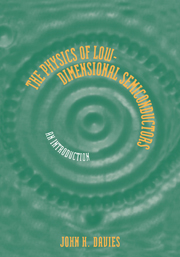Book contents
- Frontmatter
- Contents
- Preface
- Introduction
- 1 FOUNDATIONS
- 2 ELECTRONS AND PHONONS IN CRYSTALS
- 3 HETEROSTRUCTURES
- 4 QUANTUM WELLS AND LOW-DIMENSIONAL SYSTEMS
- 5 TUNNELLING TRANSPORT
- 6 ELECTRIC AND MAGNETIC FIELDS
- 7 APPROXIMATE METHODS
- 8 SCATTERING RATES: THE GOLDEN RULE
- 9 THE TWO-DIMENSIONAL ELECTRON GAS
- 10 OPTICAL PROPERTIES OF QUANTUM WELLS
- A1 TABLE OF PHYSICAL CONSTANTS
- A2 PROPERTIES OF IMPORTANT SEMICONDUCTORS
- A3 PROPERTIES OF GaAs–AlAs ALLOYS AT ROOM TEMPERATURE
- A4 HERMITE'S EQUATION: HARMONIC OSCILLATOR
- A5 AIRY FUNCTIONS: TRIANGULAR WELL
- A6 KRAMERS–KRONIG RELATIONS AND RESPONSE FUNCTIONS
- Bibliography
- Index
8 - SCATTERING RATES: THE GOLDEN RULE
Published online by Cambridge University Press: 05 June 2012
- Frontmatter
- Contents
- Preface
- Introduction
- 1 FOUNDATIONS
- 2 ELECTRONS AND PHONONS IN CRYSTALS
- 3 HETEROSTRUCTURES
- 4 QUANTUM WELLS AND LOW-DIMENSIONAL SYSTEMS
- 5 TUNNELLING TRANSPORT
- 6 ELECTRIC AND MAGNETIC FIELDS
- 7 APPROXIMATE METHODS
- 8 SCATTERING RATES: THE GOLDEN RULE
- 9 THE TWO-DIMENSIONAL ELECTRON GAS
- 10 OPTICAL PROPERTIES OF QUANTUM WELLS
- A1 TABLE OF PHYSICAL CONSTANTS
- A2 PROPERTIES OF IMPORTANT SEMICONDUCTORS
- A3 PROPERTIES OF GaAs–AlAs ALLOYS AT ROOM TEMPERATURE
- A4 HERMITE'S EQUATION: HARMONIC OSCILLATOR
- A5 AIRY FUNCTIONS: TRIANGULAR WELL
- A6 KRAMERS–KRONIG RELATIONS AND RESPONSE FUNCTIONS
- Bibliography
- Index
Summary
Fermi's golden rule is one of the most important tools of quantum mechanics. It gives the general formula for transition rates, the rates at which particles are ‘scattered’ from one state to another by a perturbation. ‘Scattered’ is in quotation marks because it is a much more general concept than one might guess. An obvious example is provided by impurities in a crystal, which scatter an electron from one Bloch state to another. They change its momentum but not its energy. Similarly, phonons (vibrations of the lattice) also scatter electrons, but in this case they change the energy of the electrons as well as their momentum. A less obvious example is the absorption of light, which can be viewed as a scattering process in which an electron collides with a photon. The converse process also occurs, where an electron loses energy to a photon, and gives rise to spontaneous and stimulated emission. Thus scattering is a remarkably general concept.
The examples suggest that there are two broad classes of scattering processes that we should treat:
(i) potentials that are constant in time, such as impurities in a crystal, which do not change the energy of the particle being scattered;
(ii) potentials that vary harmonically in time as cos ωqt, such as phonons and photons, which change the energy of the particle by ±ħωq.
- Type
- Chapter
- Information
- The Physics of Low-dimensional SemiconductorsAn Introduction, pp. 290 - 328Publisher: Cambridge University PressPrint publication year: 1997



